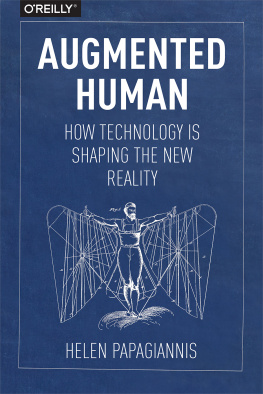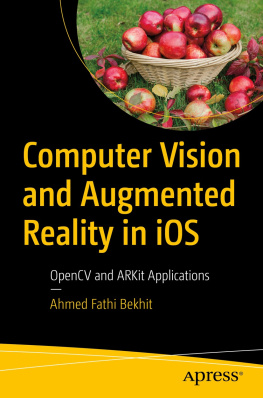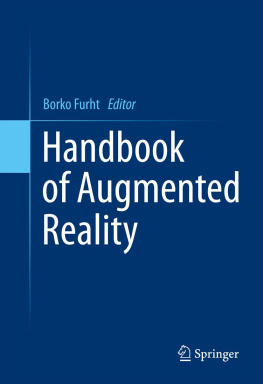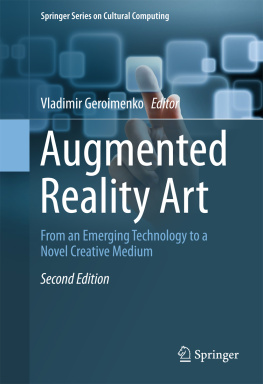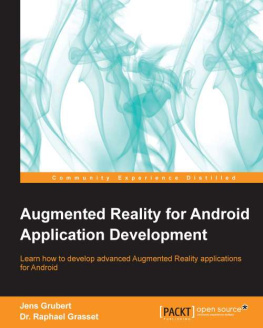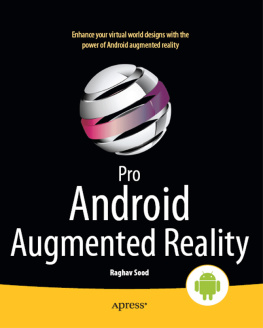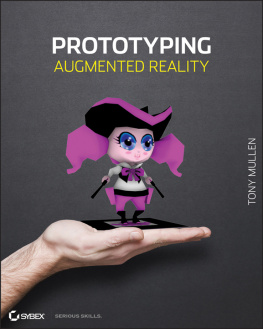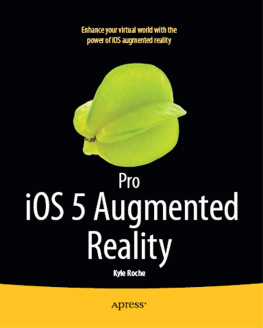Praise for Augmented Human
Augmented Human, like its author, is deeply insightful, inspiring, and conscientious about the future of humanity. This book is your guide to imagining and building fulfilling new realities. It is a must-read for anyone who wants a look at whats new and next.
Soraya Darabi,
Entrepreneur and Investor, Founder of Trailmix Ventures
This book provides a thorough overview of all the different ways we are augmenting humans, and the ways in which these augmentations can be used to create new methods of communication and storytelling. Augmented Human teases the endless possibilities of this new medium.
Jody Medich,
Director of Design for Singularity University Labs
This is the most comprehensive and useful guide into Augmented Reality I have ever seen. Not only did I learn a lot, I will apply it into our work.
Stefan Sagmeister,
Designer and Cofounder, Sagmeister & Walsh Inc.
Augmented Human
by Helen Papagiannis
Copyright 2017 Helen Papagiannis. All rights reserved.
Printed in the United States of America.
Published by OReilly Media, Inc. , 1005 Gravenstein Highway North, Sebastopol, CA 95472.
OReilly books may be purchased for educational, business, or sales promotional use. Online editions are also available for most titles (http://oreilly.com/safari). For more information, contact our corporate/institutional sales department: 800-998-9938 or corporate@oreilly.com .
- Editors: Susan Conant and Jeff Bleiel
- Production Editor: Nicholas Adams
- Copyeditor: Bob Russell, Octal Publishing Inc.
- Proofreader: James Fraleigh
- Indexer: Wendy Catalano
- Interior Designer: Monica Kamsvaag
- Cover Designer: Edie Freedman
- Illustrator: Rebecca Demarest
- August 2017: First Edition
Revision History for the First Edition
- 2017-08-10: First Release
See http://oreilly.com/catalog/errata.csp?isbn=9781491928325 for release details.
The OReilly logo is a registered trademark of OReilly Media, Inc. Augmented Human, the cover image, and related trade dress are trademarks of OReilly Media, Inc.
While the publisher and the author have used good faith efforts to ensure that the information and instructions contained in this work are accurate, the publisher and the author disclaim all responsibility for errors or omissions, including without limitation responsibility for damages resulting from the use of or reliance on this work. Use of the information and instructions contained in this work is at your own risk. If any code samples or other technology this work contains or describes is subject to open source licenses or the intellectual property rights of others, it is your responsibility to ensure that your use thereof complies with such licenses and/or rights.
978-1-491-92832-5
[LSI]
Foreword
When Helen told me that she was authoring Augmented Human: How Technology is Shaping the New Reality, I volunteered (actually begged her) to let me write this foreword. At the time, I had not read a manuscript and had only an inkling of what she was going to say, but knowing Helens scholarly reputation and thoughtfulness, I knew that her take on the emerging technology of augmented reality and its applications in augmenting humans would be insightful, if not profound.
There have been a lot of people who have worked together to create this new medium. For many years it was looked upon as a novelty or solution looking for a problem to solve. There wasnt enough crowd appeal to move it past the tipping point of mass adoptionthis being necessary for enough investment and attention toward making AR economically viable, and thus, widespread. My qualification for writing this foreword stems from the dubious honor of being one of those so-called pioneers who suffered through the beginnings of AR technology development.
In my case the journey began 52 years ago, when as a USAF officer at Wright-Patterson Air Force Base, I worked on designing better cockpits for fighter aircraft and other military vehicles. My job was to solve the problem of getting bandwidth to and from the pilots brain given the sheer complexity of the systems they needed to operate in highly stressful and dangerous environments. This problem is what motivated me to explore augmented reality approaches that might increase pilot awareness of the relationship of their aircraft and to the real world. The idea was to organize and portray information in the form of virtual images projected and superimposed over the real world via helmet worn devices. Later I extended this work to include virtual reality.
Now that AR and VR technology is finally maturing (it took longer than I had thought) my role as a tool builder is coming to an end. It is time to hand the torch to Helen and her cohort to make it do something useful. It is one thing to build a new medium but another thing to put a message in that medium. In the end, the message is more important.
As I anticipated, Dr. Papagiannis has done a splendid job in this authoritative book. It is short but packs a wallop. She has laid a foundation for us by describing what we mean by augmented reality with its various modalities, developed a taxonomy to help us categorize applications and introduced us to the content and applications (along with their pioneers). But she has gone a lot further. In connecting the dots, Helen leads us to realize that AR is not going to be business as usual. This is not about a new mediumit is about augmenting humans. It is not about separating us from experiencing the real world, as television, film and even virtual reality require, but instead, allows technology to blend with the real world, enhancing us in that total blended experience. From this perspective she shows us that AR has the power to empower, and that we need to expand our thinking (and imagination) of what this augmentation can mean to being human in the future.
When it comes to the message delivered by the AR medium, there will be many new degrees of freedom such as non-linear storytelling and alternative realities that change even the physics of experience. As Helen explains we need to throw out the old rulebook of how we understand and interact within the real world. As we embrace these new experiences and their saliencies she envisions an unleashing of discovery, creativity, imagination and what it may mean to be an augmented human in the days to come. No doubt hers is not the final word, but it is an essential and necessary touchstone as we embark on this human augmentation odyssey.
I especially appreciate Helens insight and sensitivity about the role of artists (or wonderment operators as she calls them) as a stimulus to emergence. My own experience is that there is not one community that owns this space. It is as much a place for storytellers and artists as it is for engineers and computer scientists. The experience is what we will remember and will change us. Hopefully the technology (my contribution) becomes invisible and doesnt get in the way.
I take to heart Helens final charge at the conclusion of this book that we need to work together as a civilization to use the tools of our age to lift humanity and inspire a positive change in the world. For in the end, we must answer the question: does augmenting us make our lives better?
Tom Furness,
Grandfather of AR/VR and Founder of the Virtual World Society, Seattle,
July 16, 2017
Preface
Why I Wrote This Book
Twelve years ago, I caught my first glimpse of the power of Augmented Reality (AR) as a new communication medium. It was pure magic: a virtual 3-D cube appeared in my physical surroundings and I was awestruck. The augmented cube demo wasnt interactive at the time (it did nothing else other than appear), however, it ignited my imagination for how AR could grow and evolve. At that moment, I dedicated my creative work, research, and public speaking to the new experiences AR made possible.

